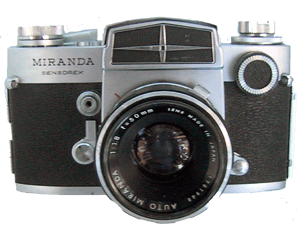
Lens Mount: Miranda bayonet / Miranda 44mm screw mount
Battery: one 625 or equivalent
Approx. dates of manufacture: 1966 to 1972
Approx. original price: $264.95
Approx. street value: moderate
I always wanted a Miranda. I used to read camera magazines from the 1960s and they were highly regarded. They seemed like the chief competitor against Nikon as a system camera. They both had full lines of interchangable accessories—something many of their competitors wouldn't have until the 1970s.
The Sensorex was Miranda's most popular camera. Came out in 1966 and ran through 1972, the height of Miranda's popularity and influence. It has the two trademark design features of a Miranda camera: the interchangable prism (the Nikon F was the only other japanese 35mm camera at the time with this feature); and the front-mounted shutter release.
Another unusual feature was a dual lens mount. There was an outer flange for the Miranda bayonet mount; but if you look at it, the inside is threaded to accept the 44mm Miranda screw-mount. Miranda also sold a number of a adapters to accept various other lens makes, including the standard 39mm and 42mm screw-mounts; the idea being that a lot of people with a sizable investment in quality optics would buy a Miranda body rather than replace all that glass.
Yet another quirk was the metering setup. Earlier Mirandas has a spot-meter in the center of the frame; the Sensorex/Sensomats went with bottom-weighted averaging, which they said elminated overexposure problems due to a bright sky.
The Sensorex and Sensomat were sisters and very closely related. The difference was the external coupling arm between lens and body; the Sensorex has it, the Sensomat did not. The coupler allowed the Sensorex to meter at full aperture and then stop-down only for taking; the Sensomat required the lens to be stopped-down during metering, which many people (hi there) find annoying.
My camera has obviously been around. There are a couple dings in the pentaprism housing and the latch in the lens is worn so the lens won't stay locked into place; but if I wanted to use this camera seriously, I could get another lens for it without much touble (and you can keep it on, you just have to be careful when turning it).
Still, it's a piece of work. It's heavy, even for its time, but it also feels solid and trustworthy. It looks like the kind of camera where a lot of engineering thought went into it. The controls are comfortable, it fits nicely in my hand, and I could figure out almost all of it without having to read the manual. Sad that people who made something like this went out of business, when so many lesser manufacturers survived.
One of Modern Photography magazine's Top Cameras
Camera manual: Orphan Cameras.com
Modern Photography magazine camera test: January 1970


